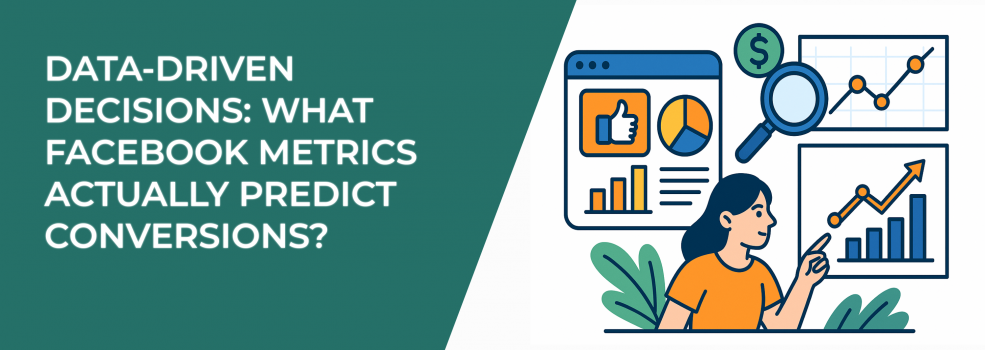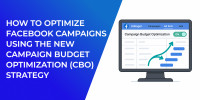Facebook Ads can feel like a numbers game, but which numbers actually matter?
If you’ve ever stared at your Ads Manager dashboard wondering whether a high click-through rate is cause for celebration or concern, you’re not alone. Advertisers often rely on the metrics Facebook provides, but not all of them tell the full story. Worse, some can be misleading if taken at face value.
So how do you know which metrics are truly connected to conversions, and which are just vanity?
Let’s break it down.
The Problem with Surface Metrics
When campaigns are live and running, it’s tempting to latch onto the most obvious indicators: reach, impressions, likes, even CTR. These are the easiest to read, and they move fast. But they don’t always signal real outcomes.
A high click-through rate can feel validating. So can a low cost-per-click. But neither of those guarantees someone actually bought your product, signed up for your offer, or booked a demo.
What if people are clicking — but bouncing? What if you’re targeting the wrong intent?
This is where being data-driven means more than just watching numbers rise and fall. It means asking smarter questions.
Metrics That Hint at Conversions (But Don’t Guarantee Them)
Let’s talk about the “almost” indicators. These metrics can point toward a successful campaign, but only when viewed in the right context.
1. Click-Through Rate (CTR)
A high CTR often suggests your creative and messaging are resonating. But it doesn’t confirm that people converted after the click. If CTR is strong but conversions are flat, the problem may lie in your landing page, offer mismatch, or even load speed.
CTR may look impressive on its own, but this chart shows how it doesn’t always translate to conversions — CVR reveals the real performance story.
2. Cost Per Click (CPC)
Low CPC feels like efficiency, and sometimes it is. But if you're paying pennies for low-quality clicks that never convert, you’re still wasting budget. Watch for trends — are cheap clicks leading to actions, or just noise?
3. Engagement (Likes, Shares, Comments)
Strong engagement can improve your ad relevance score, but social proof doesn't always drive sales. In fact, posts that go viral often do so for entertainment, not conversion potential. Unless your goal is awareness, be careful not to equate popularity with performance.
The Metrics That Actually Predict Conversions
Now let’s shift focus to what truly matters when it comes to bottom-line performance. These metrics, when tracked correctly, give you the clearest signals about what’s working — and why.
1. Conversion Rate (CVR)
This is your North Star. It tells you the percentage of people who clicked your ad and then took your desired action — whether that’s a sale, signup, or another goal. Watch this closely across ad sets, creatives, and audiences. If CVR is low, that’s a red flag, even if everything else looks great.
2. Cost Per Conversion (a.k.a. Cost Per Result)
More useful than CPC, this metric shows how much you’re actually paying for each conversion. It keeps your attention where it matters — ROI. And when paired with CVR, it helps you identify which ad elements are truly efficient.
3. ROAS (Return on Ad Spend)
The ultimate performance metric. ROAS tells you how much revenue you’re earning for every dollar spent. If your campaign shows a ROAS above your break-even point, you’re on track. If not, it’s time to rethink targeting, creative, or funnel steps.
4. Conversion Events via Pixel or API
Don’t rely on platform-side data alone. Make sure your Meta Pixel or Conversions API is correctly set up and firing. These events allow you to track specific user behaviors — purchases, adds-to-cart, lead form completions — that happen after the click. No guesswork, just real actions.
Not sure if you're chasing the right KPIs? You might also want to explore how to analyze Facebook ad performance beyond CTR and CPC to avoid wasting time on the wrong metrics.
How to Connect the Dots
Here’s where many advertisers miss the mark: reading metrics in isolation. A high CTR might look great — but if conversions are low, something’s off. You have to look at how your numbers work together.
For example, if your CTR is strong but conversion rate is weak, your ad is doing its job, but your landing page might not be. Maybe the messaging doesn’t match. Maybe the page is slow. Test your copy, layout, or even your offer.
Now let’s say your CPC is going up, but so is your ROAS. That’s not a bad thing. You’re probably reaching higher-quality leads. If those clicks are converting and bringing in real revenue, they’re worth the extra cost.
Or maybe your engagement is high, but CTR is low. People like your ad — but they’re not clicking. Chances are, your call to action isn’t clear or compelling enough.
The key is to ask: What happens next? If one number looks good, but nothing else follows, dig deeper.
Don’t just chase low CPCs or high likes. Follow the full journey from impression to conversion and make decisions based on the whole picture.
That’s how you turn data into real performance.
If you’ve optimized your creative but still see poor conversion behavior, this guide on why Facebook Ads aren't converting and how to fix it can help troubleshoot deeper issues.
Final Tips for Smarter Metric Tracking
Want to get more out of your Facebook Ads? Don’t just track numbers — look at what they mean. Here’s what to focus on:
-
Compare performance over time and across audiences. A strong CTR or ROAS in one campaign might not hold up in another. Check trends week to week, and break down results by age, gender, device, or location to spot real patterns.
-
Avoid focusing on just one metric. A low CPC doesn’t help if no one converts. A high CTR means nothing if people bounce after the click. Always connect metrics back to your true goal — conversions and revenue.
-
Use custom conversions that reflect your business. Don’t rely only on Facebook’s default events. Set up conversions that track what actually matters — purchases, booked calls, sign-ups, or content views. That’s how you measure real outcomes.
-
Track the full funnel, not just the first step. Getting the click is just the beginning. Where are users dropping off? If people aren’t finishing the form or completing checkout, that’s where to optimize next. Not all objectives are created equal. Learn how to set up performance-driven Facebook campaign objectives to make sure you’re optimizing for what moves your bottom line.
When you stop chasing vanity metrics and start looking at the full picture, you’ll make sharper, more profitable decisions — and your data will finally start working for you.
Are You Measuring What Matters?
Vanity metrics are easy to celebrate, but they don’t pay the bills. Real success with Facebook ads comes from knowing what to watch and what to ignore.
Take a step back from the dashboard. What’s really driving outcomes in your business? That’s where your focus belongs.
And if you’re unsure where to begin? Start by asking this: “If this number goes up, do I actually make more money?”
If the answer’s no, it’s not your metric.

